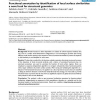151 search results - page 14 / 31 » Classifying protein sequences using hydropathy blocks |
AI
2005
Springer
13 years 7 months ago
2005
Springer
Abstract. The protein family classification problem, which consists of determining the family memberships of given unknown protein sequences, is very important for a biologist for ...
BMCBI
2005
13 years 7 months ago
2005
Background: Protein function is often dependent on subsets of solvent-exposed residues that may exist in a similar three-dimensional configuration in non homologous proteins thus ...
CSB
2002
IEEE
14 years 20 days ago
2002
IEEE
Understanding the functional significance of alternative splicing and other mechanisms that generate RNA transcript diversity is an important challenge facing modern-day molecular...
BMCBI
2007
13 years 7 months ago
2007
Background: Odorant binding proteins (OBPs) are believed to shuttle odorants from the environment to the underlying odorant receptors, for which they could potentially serve as od...
BMCBI
2010
13 years 7 months ago
2010
Background: Recombinant protein production is a useful biotechnology to produce a large quantity of highly soluble proteins. Currently, the most widely used production system is t...

